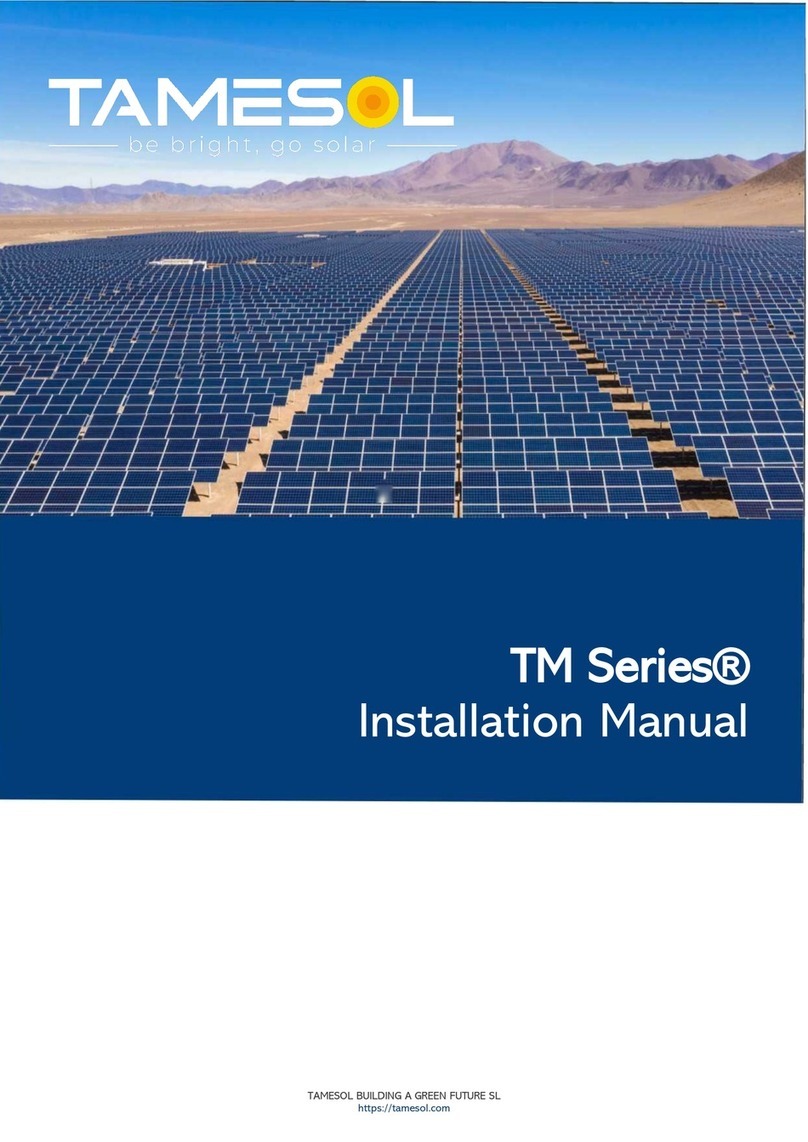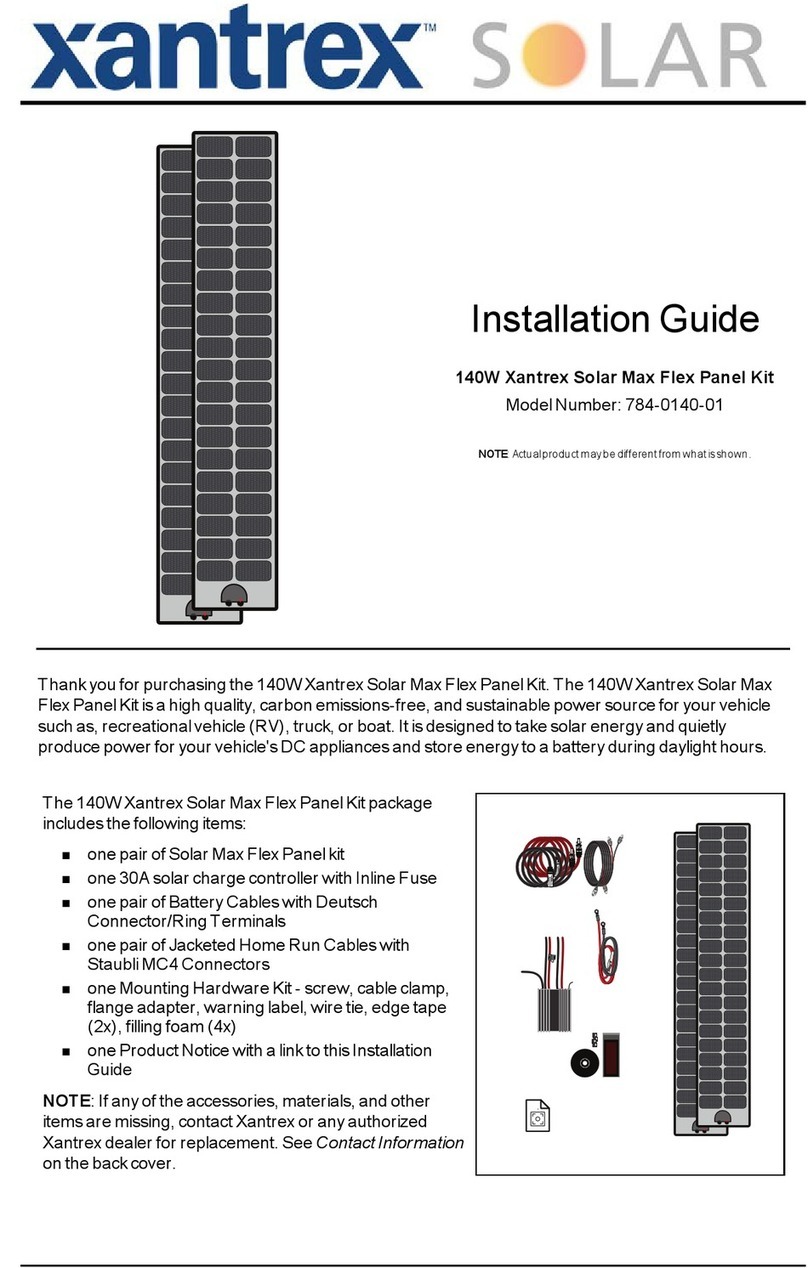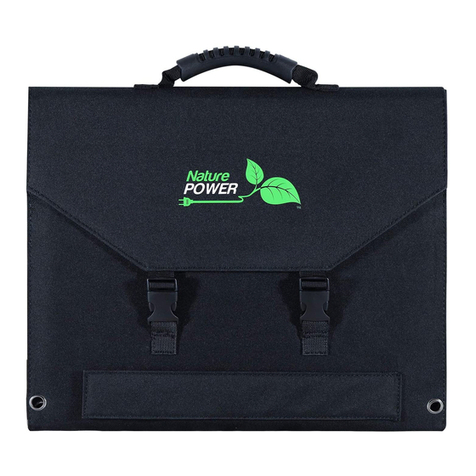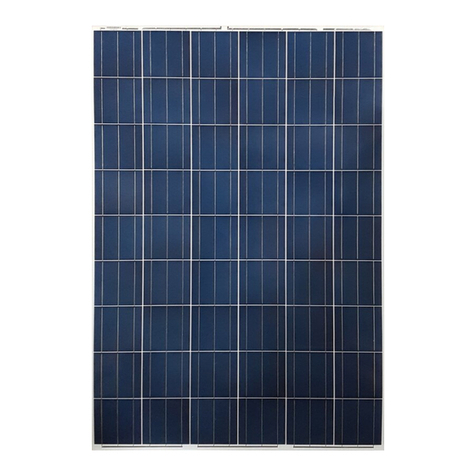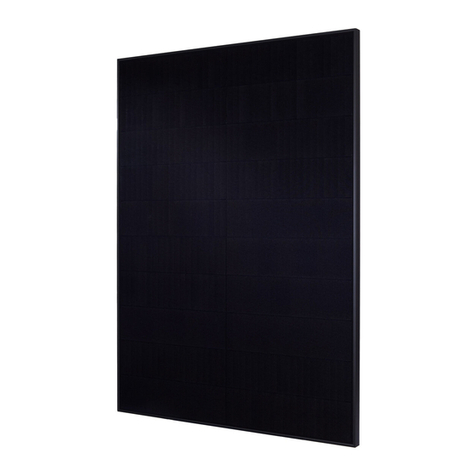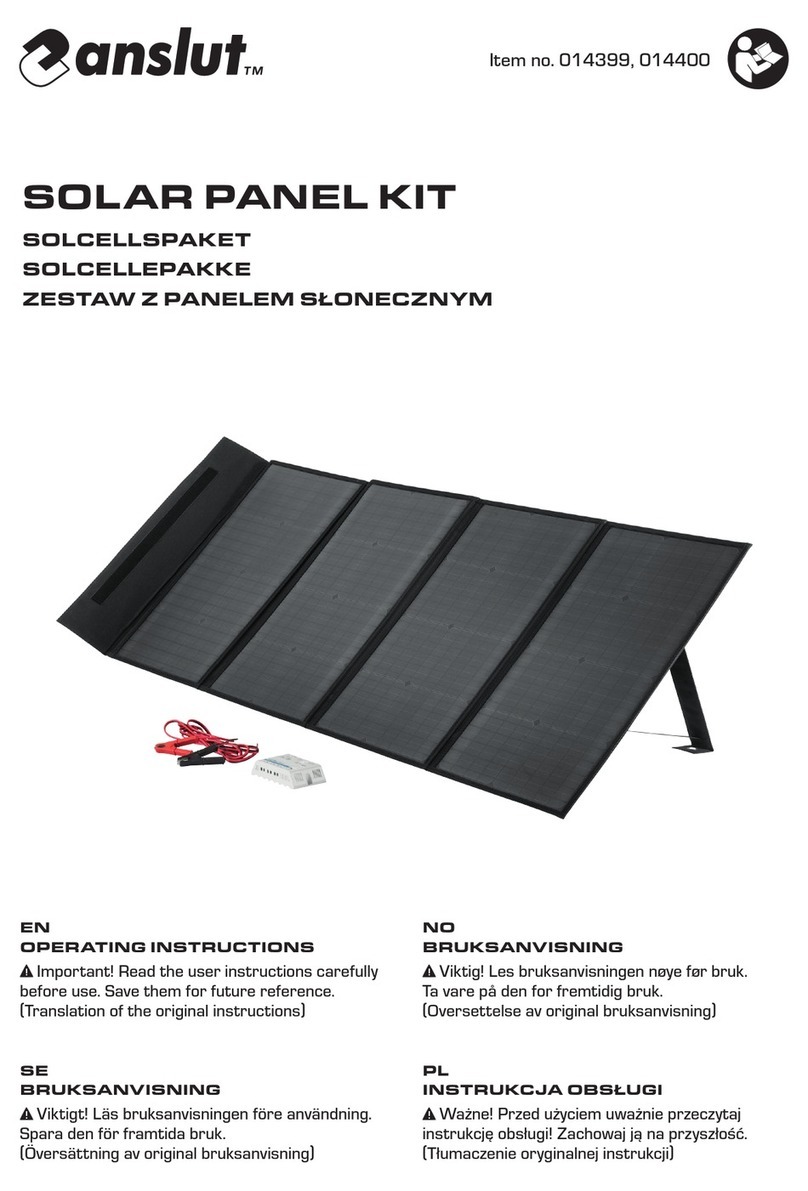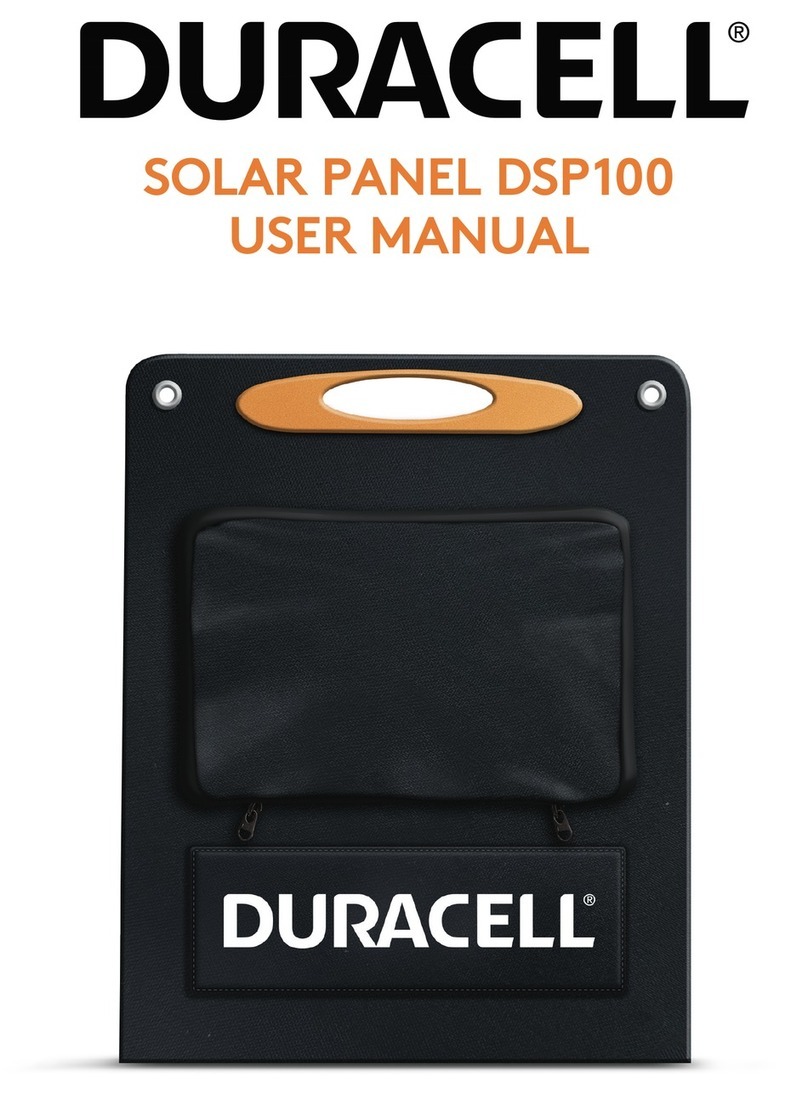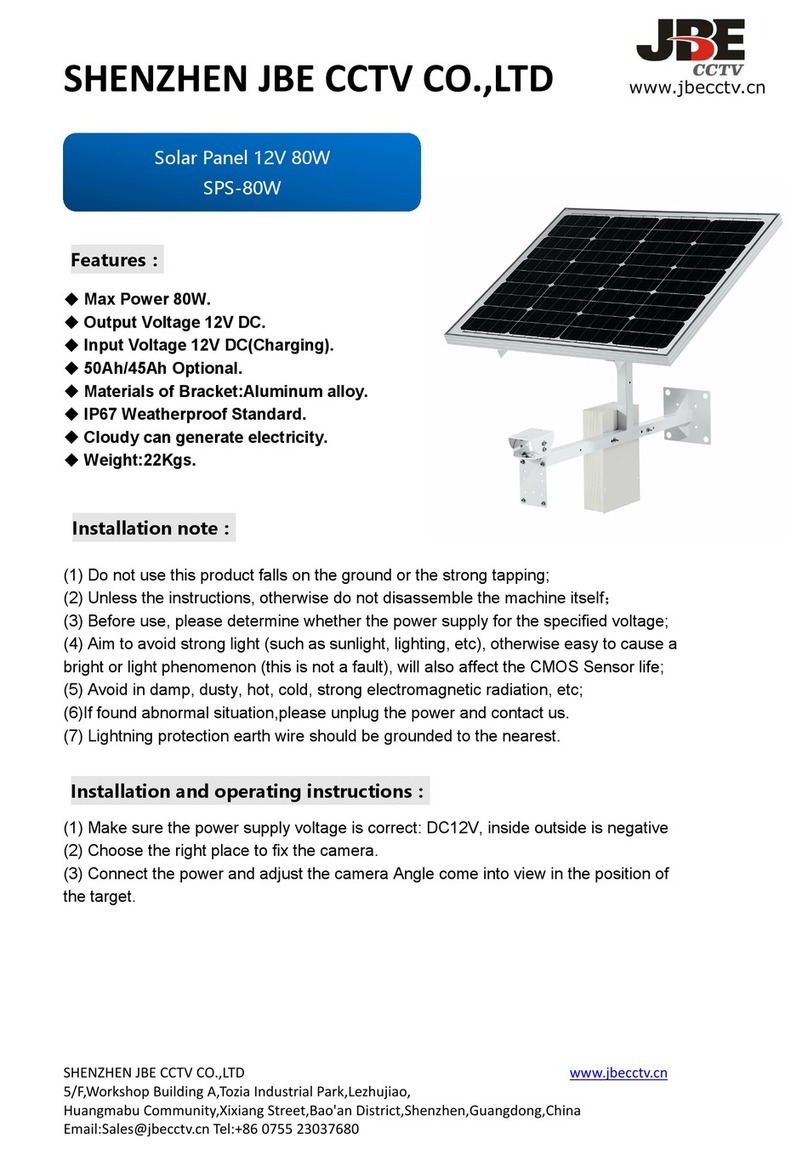Solene SLAR32DC-66 User manual

OPEN LOOP DOMESTIC HOT WATER SOLAR SYSTEM
WITH DIFFERENTIAL CONTROL
MODELS SLAR32DC-66, SLAR40DC-80
SLAR64DC-120, SLAR80DC-120
INSTALLATION MANUAL
Solene™
™
927 Fern St. Suite 1500
Altamonte Springs, FL 32701
(866) 902-0060
SRCC OG-300 Certified
The solar energy system described by this manual, when properly installed and maintained, meets the
minimum standards established by the Florida Solar energy center, in accordance with section 377.705,
Florida Statutes. This certification does not imply endorsement or warranty of this product by the Florida
Solar Energy Center or the State of Florida.
The solar energy system described by this manual, when properly installed and maintained, meets the
minimum standards established by the Florida Solar Energy Center, in accordance with Section 377.705,
Florida Statutes. This certification does not imply or endorse warranty of the product by the Florida Solar
Energy Center of the State of Florida. Solar Water Heating System
SLAR-IMDC
9-04-09

2
TABLE OF CONTENTS
egaP
3snoituacerPytefaS
3snoitcurtsnInoitallatsnI
3noitatneirO&gniziS
4noitallatsnIhsulF-gnit
nuoMrotcelloC
6noitallatsnIdelgnA–gnitnuoMrotcelloC
8noitallatsnIepiP
9gnibmulP
9lortno
ClaitnereffiDcitamotuA
01stnemeriuqeRgniriW&lacirtcelE
01sretemomrehT
01serudecorPpU-trat
SmetsyS
11noitarepOmetsyS
11noitarepOraloSlatoT
11taeH-erPraloS
11rewoPytilitUlatoT
System Schematic (SLAR32DC-66 & SLAR40DC-80) 12
System Schematic (SLAR64DC-120 & SLAR80DC-120) 13
41
noitcnuFdnatsiLstraPtnenopmoC
51ycnatcepxEefiLtnenopmoC
51noitamrofnItcatnoC
61slebaLAurora
81ytnarraWAurora

3
SAFETY PRECAUTIONS
There is no substitute for safety. Always exercise extreme caution, care and good judgment
when working on or around a roof. Here are just a few installation precautions to keep in mind:
When working on the roof, always take care to avoid hazards such as overhead electrical
wires or loose shingles. Secure ladders so they will not slip or fall. Wear shoes with
proper tread to prevent slipping on the ladder or sloped roof areas.
Always check that power is turned off before attempting any wiring or electrical hook-
ups, especially when water is present. It’s always a good idea to shut power off to both
the solar storage tank and to the automatic control when there is water leaking at the tank.
Do not hook up or turn on any electricity to the solar storage tank until it is full of water. If the
heating element is not covered in water prior to being turned on, it will burn out.
Always consult the proper authorities or check with your local building department for the
permit requirements and codes applicable before you start the job. Installation should always be
in accordance with the National Fire Code and with all local codes.
INSTALLATION INSTRUCTIONS
SIZING & ORIENTATION
The vast majority of Solar Domestic Hot Water (SDHW) systems are comprised of “Medium
Temperature” solar collectors manufactured using tempered glass and some type of metal
absorber plate. They differ from “Low Temperature” systems predominantly utilized in
swimming pool heating applications. These systems are typically manufactured using plastic
resins. “High Temperature” systems are utilized to generate steam for industrial applications.
Corona collectors belong to the “Medium Temperature” category.
Normally, only one or two Aurora collectors are needed for a SDHW system. The number of
collectors is determined not only by the amount of water that is needed, but also by the latitude
of the installation and the collector’s orientation. The following table details Corona’s
recommended minimum system sizing guide for a typical installation:
Tank
Capacity # of Collectors
Needed Collector Type Control Type System Model
Number
66 gallon 1 SLAR-32 (4’ x 8’) Differential
Control SLAR32DC-66
80 gallon 1 SLAR-40 (4’ x 10’) Differential
Control SLAR40DC-80
120 gallon 2 SLAR-32 (4’ x 8’) Differential
Control SLAR64DC-120
120 gallon 2 SLAR-40 (4’ x 10’) Differential
Control SLAR80DC-120

4
Normally, collectors are installed on roofs, as close as possible to the tank, to minimize heat loss
through the pipe. The pipes between the tank and the collectors MUST be insulated with at least
½” thick insulation, for the same reason.
The solar collectors must be located in a structurally sound area of the roof that will be exposed
to the sun for the majority of the day, all year round.
The recommended angle of the collectors is the angle of the installation location’s LATITUDE.
This angle is designed to maximize solar absorption during winter months when the sun is low.
A variation of +/- 15 degrees is acceptable. The orientation of the collectors must be due south
55 degrees. Flush mounts on available roof slopes are recommended to allow convenience and
cost effectiveness, since these variations from the exact angle and orientation will affect the
system’s performance only by about 5%.
COLLECTOR MOUNTING
There are two basic roof-mounting methods:
FLUSH MOUNT INSTALLATION - Parallel to the roof line, as illustrated below.
Figure #1, Flush mounted collector
Flush Mount Installations are recommended when the roof’s slope conforms to the orientation
requirements as stated previously. This is the easiest and most aesthetically pleasing installation
method. After the collector(s) are installed, it should resemble skylight. The flush mount
consists of four (4) U-channels (SL-UC) and four (4) Gripper Sets (SL-GS), two set each for the
top and bottom.
1. Start from the bottom. The bottom side of the Corona collector is marked by two weep
holes placed about 20” apart on the short anodized aluminum edge of the collector.
When elevating the collector to the roof, make sure that the “weep holes” are facing
down. It is recommended to install the collectors vertically (length up the roof’s slope),
but the collectors may be installed horizontally as well.
2. Once the collector’s location is determined, anchor two (2) U channels to the roof using
two (2) stainless steel 2” x 5/8” lag bolts for each U-channel. The U-channels should

5
be spaced approximately 30” apart. The collectors will rest on top of the U-channels.
(Picture 1)
Picture #1
3. Verify a secure connection to the trusses. If lagging directly into the roof trusses is not
possible, secure a 2’ x 4’ wood beam perpendicular to the trusses, inside the attic, and
anchor the bolts to this member. Again, verify a secure connection into the new
member.
4. Connect the Latch to the Gripper (Picture 2) utilizing the provided nut and bolt. Slide
the Latch into the top of the U channel so that the Gripper remains on top of the
opening. Place them at the middle of the U-channel’s top and tighten. (Picture 3)
Picture #2 Picture #3
5. Loosen the Gripper providing space to insert the slot at the collector’s edge between the
Gripper’s hook and the U-channel’s top. Once both Grippers are grabbing the
collector’s edge slot, tighten both Grippers. (Picture 4)
Picture #4 Figure #3
6. Repeat steps 2-5 for the top. That’s it. The collector is anchored.

6
ANGLE MOUNT INSTALLATION - Not parallel to the roofline, normally used on flat roofs and
ground mounts, as illustrated below.
Figure #2, Angle mounted collector
Angle Mount Installations involve positioning the collector(s) at an angle so that the upper part
of the collector is higher than the lower in reference to the mounting surface. The “angle
mounting” is used on horizontal surfaces or on roofs that slope in directions other than south 55
degrees.
1. Use the Angle Mounting kit (SL-MK), see picture 5. Connect the U-channels to the
roof just like in the Flush Mounting method. Assemble the mounting clips to both U-
channels utilizing the provided bolts (Picture 6).
Picture #5 Picture #6
2. Screw the mounting clips to the BOTTOM part of the collector (the weep hole side)
using two (2) stainless steel or aluminum screws each. (Picture 7)
Picture #7
3. Assemble both rods and top mounting clips (picture 8). Connect the clips to the
collector’s top by stainless steel or aluminum screws. (Figure 4)

7
Picture#8 Figure#4
4. Connect to the U-channels to the opposite side of the rod, using the provided nuts and
bolts. (Picture #10)
Picture #10
5. Lift the collector’s top with the assembled rod kits and anchor the U-channels to the
roof, ensuring the proper angle to the collectors. (Picture 11)
Picture #11
Install all components in accordance with local code so that the performance of any structural
member or fire rated assembly is not reduced.

8
PIPE INSTALLATION
Careful consideration of the proper piping of the system should be done prior to a final decision
being made on the collector mounting. The collectors and piping should slope slightly
downward, toward the tank, in order to allow for draining in freezing conditions.
Piping should consist of copper tube (Type M), insulated with at least ½” Armaflex pipe
insulation or similar and be wrapped with aluminum tape in all areas exposed to UV radiation.
All soldered connections require 95/5 solder.
The cold-water inlet (supply) pipe connection should be made at the lowest corner of the
collector. The hot-water outlet (return) pipe connection should be made at the opposite corner of
the cold-water inlet. The hot-water return should have the shortest possible run back to the
storage tank to avoid heat loss.
The Vacuum Relief Valve (Part #6), Automatic Air Vent (Part #7), Pressure Relief Valve (Part
#8), and Freeze Protection Valve (Part #5), should be plumbed into the return line as illustrated
in the System Schematic on page 12 of this manual.
It is extremely important to take special care in weather proofing the piping installation through
the roof.
1. Drill a hole the same diameter as the copper piping being utilized in the system
installation being careful not to place the opening above the collector supply point.
The system will not drain properly if the opening is above the above the supply point.
2. Cement a copper roof flashing around the pre-drilled hole. The upper edge of the
flashing should slide underneath the adjoining shingle.
3. Push the copper tube up through the roof flashing. Slide the flashing cap over the
copper tubing so it rests on the flashing opening. The wiring for the Photovoltaic
Module should also be run through this the return line flashing.
4. After all of the piping is completed, solder the flashing cap into place.
5. Utilizing a polybutalyne adhesive, finish weather proofing the roof flashing.

9
PLUMBING
The storage tank should be placed in a location to best minimize heat loss. It should be placed as
close to the system return line as possible. Adequate ventilation and access for possible future
service work are important considerations. In order to prevent possible water damage in case of
tank leakage, a pan with a ¾” drain line should be installed.
As illustrated in the System Schematic on page 12 of this manual there are very specific
requirements as to valve, thermostat, and pump placement.
The following component equipment should solder in place according to their specific relative
locations as outlined in the System Schematic.
1. Circulation Pump (Part #4) - Taco 006BC4 Circulation Pump
2. Thermometers (Part #11) - Letro SL-2D In-Line Thermometer w/ temperature range
of 50to 220 F.
3. Boiler Drains (Part # 12) - BD-050 (½”), or BD-075 (¾”) Boiler Drains on both
Supply and Return lines.
4. Ball Valves (Part #14) - BV-050 (½”), or BV-075 (¾”) Ball Valves on both
Supply and Return lines.
5. Cold Water Inlet Valve - GV-075 (¾”) Gate Valve.
6. Mixing Valve - Watts 70A-075 (¾”) Mixing Valve.
AUTOMATIC DIFFERENTIAL CONTROL
Power to the circulation pumps is controlled by an automatic differential control that has two
temperature sensors. One sensor is located on the outlet of the solar collector and the other
sensor is located on the storage tank behind the lower access panel. When the storage tank
sensor detects water temperatures cooler than the desired temperature set on the control, and if
the collector sensor is 8F warmer than the storage tank sensor, the automatic control turns on
the circulation pump to harvest the energy available from the sun. When the desired temperature
is met, or when the solar collector sensor drops to within 4 degrees of the storage tank sensor, the
control turns off the circulation pump. (This on/off differential can be set to 24º/4º rather than
the 8º/4º.)
The automatic control has a three-position switch - ON, AUTO or OFF. (Sometimes this switch
is located on the inside of the cover.) During normal operation, the control is switched to AUTO
where the control will turn the circulation pump on and off at the appropriate times. When
switched to ON, the control sends power to the circulation pump. When switched to OFF, the
control turns the circulation pump off.
THE AUTOMATIC CONTROL HAS A HIGH LIMIT STORAGE SETTING THAT CAN BE ADJUSTED
FROM 110°F TO 200ºFAND IS TYPICALLY PRESET TO 140°F.

10
ELECTRICAL AND WIRING REQUIREMENTS
A properly licensed contractor must make the 230-volt electrical connection to the water heater
or solar storage tank and the electronic time switch (Optional). If your solar contractor is not
allowed by law to make these connections consult a licensed electrician.
NEVER ACTIVATE THE CIRCUIT BREAKER CONTROLLING THE ELECTRICAL HEATING ELEMENT
UNTIL THE SOLAR STORAGE TANK IS COMPLETELY FILLED WITH WATER.This will prevent
“dry firing” of the heating element. The electrical heating element will be destroyed almost
instantaneously if not completely submerged in water when activated. Make sure the water
heater circuit breaker is off until the solar storage tank is completely filled.
We recommend the use of a 115-volt differential control with a factory installed six-foot line
cord. The installation requires one 115-volt outlet to be installed near the solar storage tank.
Plug the control into the outlet. The circulation pump line cord is plugged into the receptacle on
the side of the controller. A 230-volt control and circulation pump may be substituted, but
troubleshooting the components in the future becomes more difficult. The specified differential
thermostat is the Goldline model GL-30-LCO.
THERMOMETERS
Locate two thermometers; one at the supply line and one on the return line of the solar loop so
that the temperature rise across the collector can be determined.
LABELS
Label installation is mandatory at several locations of the system. Please insure compliance by
affixing labels at the designated locations.
SYSTEM START-UP
The Start-up Procedures are detailed in the Solene Open Loop (SLAR-HMDC) Homeowner’s
Manual.

11
SYSTEM OPERATION
Solene systems are designed to accommodate three separate modes of operation. Your solar
water heating system can (1) provide 100% solar operation during good weather, or (2) serve as
a pre-heater to your electric water heater adding solar energy when and as available, or (3) 100 %
on utility power during inclement weather.
TOTAL SOLAR OPERATION
Turn off the circuit breaker to your solar storage tank. If a water heater time switch has been
installed, set the switch to the “off” position. If you have a mechanical timer remove the trippers
from the face of the switch.
TOTAL PREHEAT
Leave the circuit breaker to your solar storage tank on and set the tank thermostat to the lowest
acceptable temperature setting. The electric resistance heating elements will come on only when
the tank temperature falls below the thermostatic set point. If the solar heated water entering the
tank is warmer than the thermostatic set point, the electric heating elements will not come on. If
you have a water heater timer, you may preset the timer to turn the heating element on and off at
specified times throughout the day if desired.
TOTAL UTILITY POWER
Leave the circuit breaker to your solar storage tank on and close the isolation ball valves in the
collector loop. In this mode of operation you must turn off the circulation pump. To turn the
pump off, open the controller and change the operational setting from automatic to off. Failure
to turn off the pump can quickly damage the pump motor, shaft, bearings or impeller.

14
COMPONENT PARTS LIST AND FUNCTION
While specific products are mentioned below, there are many components that can be substituted
with like or equal products. For instance there are several different mixing valves or isolation
valves that can be utilized, not just the one specifically listed. Sometimes sweat or threaded
connections or varying fitting sizes are dealer preference. All of the components listed below are
available from Solene at 927 Fern St. Suite 1500, Altamonte Springs, FL 32701 (866) 902-0060.
See the schematics on page #12 & #13 for the location of the following list of components.
1. Aurora Solar Collector –Aurora SLAR40 4 x 10, or SLAR32 4 x 8 with all copper chrome
plated absorber plate.
2. Solar Storage Tank – Lochinvar FTA066K 66 Gallon, or FTA082K 80 Gallon, or FTA120K
120 Gallon Solar Storage Tank with Single 4500W Backup Element.
3. Differential Control – Goldline Differential Control with Adjustable High Limit determines
when system is on or off.
4. Circulation Pump – Taco 006BC, Grunfos, or March 80AC, circulate water through system.
5. Freeze Valve – Dole FP-45 Freeze Valve protects system from freezing.
6. Vacuum Relief Valve – Watts N-36 Vacuum Relief Valve allows air into the system when
draining collector.
7. Air Vent – Sparco FV-147 Air Vent allows air trapped in collector to purge.
8. Pressure Relief Valve – Watts 530C Pressure Relief Valve protects system from excessive
pressure.
9. Pipe Insulation – ACT05834 Armaflex Copper Pipe Insulation to prevent heat loss through
pipes. Any Pipe Insulation that is exposed to sunlight must be wrapped with foil tape or coated
with a water-based acrylic resin coating as specified by the Insulation Manufacturer.
10. Roof Penetration Flashing – All Copper Roof Flashing. Gooseneck type flashing is
recommended for feed line to accommodate sensor wire.
11. Thermometer – Letro SL-2D In-Line Thermometer w/ temperature range of 50°F to 220°F.
12. Boiler Drains – BD-050 ½’, or BD 075 ¾’ Boiler Drains on both Feed and Return lines used in
conjunction with #13 Ball Valves, allow for manually draining the solar system.
13. Check Valve – Heliodyne SCV 75/50 Check Valve for PV Systems prevents thermo-siphoning
from storage tank through solar collectors.
14. Ball Valves – BV-050 ½”, or BV-075 ¾” Ball Valves used as Isolation Valves in conjunction
with #11 Boiler Drains to manually drain the solar system.
15. Cold Water Inlet Valve – GV-075 ¾” Gate Valve gives ability to turn off the cold feed to the
Solar Storage Tank.
16. Mixing Valve – Watts 70A-075 ¾” Mixing Valve tempers temperature of hot feed line to home.
17. Pressure & Temperature Relief – Watts 100XL-4 P&T Relief Valve located on the solar
storage tank opens at 150psi or 210°F.

MODEL SLAR40DC-80
MODEL SLAR32DC-66
ROOF PENETRATION
COPPER TUBING & INSULATION
COLLECTOR SENSOR
AUTOMATIC FREEZE
VALVE
VACUUM RELIEF VALVE
AUTOMATIC AIR VENT
PRESSURE RELIEF VALVE
MANUALDRAIN
BALL VALVE
(ISOLATION VALVE)
ELECTRICALSUPPLY
PRESSURE &
TEMPERATURE RELIEF VALVE
SOLAR RETURN FROM
COLLECTOR
SOLAR HOT WATER TANK
TANK DRAIN
DIFFERENTIAL
TEMPERATURE
CONTROL
120v
COLD WATER
FROM HOUSE
RESET BUTTON
HEATING ELEMENT
THERMOSTAT CONTROL
SOLAR FEED TO COLLECTOR
SOLAR COLLECTOR
TANK SENSOR
CONTROL
SWITCH
HOT WATER TO HOUSE
MIXING VALVE
(BYPASS)
MANUALDRAIN
CHECK VALVE
BALLVALVE
(ISOLATION VALVE)
E
NI
L
NRUT
ER
R
A
L
O
S
CIRCULATION PUMP
ENILDE
E
F
RALOS
SOLENE DHW SYSTEM SCHEMATIC
PIPE
INSULATION
COLD SERVICE VALVE
1
18
16
14
15
13
5
8
9
12
10
7
6
4
2
3
18
12
14
17
11
THERMOMETER
9-04-09

ROOF PENETRATION
COPPER TUBING & INSULATION
AUTOMATIC FREEZE
VALVE
VACUUM RELIEF VALVE
AUTOMATIC AIR VENT
PRESSURE RELIEF VALVE
MANUALDRAIN
BALLVALVE
(ISOLATION VALVE)
ELECTRICALSUPPLY
PRESSURE &
TEMPERATURE RELIEF VALVE
SOLAR RETURN FROM
COLLECTOR
SOLAR HOT WATER TANK
TANK DRAIN
DIFFERENTIAL
TEMPERATURE
CONTROL
120v
COLD WATER
FROM HOUSE
RESET BUTTON
HEATING ELEMENT
THERMOSTAT CONTROL
SOLAR FEED TO COLLECTOR
TANK SENSOR
CONTROL
SWITCH
HOT WATER TO HOUSE
MIXING VALVE
(BYPASS)
CIRCULATION PUMP
SOLENE DHW SYSTEM SCHEMATIC
PIPE
INSULATION
COLD SERVICE VALVE
18
16
15
5
8
9
10
7
6
4
2
3
16
12
14
17
SOLAR
COLLECTORS
COLLECTOR SENSOR
11
MANUALDRAIN
CHECK VALVE
BALLVALVE
(ISOLATION VALVE)
E
NI
L
N
RUTE
R
RA
L
OS
ENILDEEFRALOS
14
13
12
11
THERMOMETER
MODEL SLAR80DC-120
MODEL SLAR64DC-120
MODEL SLAR60DC-80
9-04-09

15
COMPONENT LIFE EXPECTANCY
Installed and maintained properly, your Solene Solar Hot Water Heating System should provide
many years of trouble free, uninterrupted service. The main component of the system, the
Aurora Solar Collector, is designed to last 25 to 30 years. Solar Storage Tanks have a life
expectancy anywhere from 10 to 20 years depending greatly upon regional water quality. (Tank
life can be extended by replacing the internal sacrificial anode rod from time to time.)
Differential Control and Circulation Pump life expectancies run from 5 to 10 years. As electrical
components, they are susceptible to lightning strikes or electrical surges. Valve life expectancy
varies greatly depending water quality and usage.
FOR MORE INFORMATION
Detailed information regarding System Operation, Routine Maintenance, Freeze Protection, and
Start-up and Shutdown procedures can be found in the Solene Open Loop (DC) Domestic Hot
Water Solar System Homeowner’s Manual (SLAR-HMDC).
CONTACT INFORMATION
If you have any questions regarding the operation of your system, please contact your Installing
Solene Dealer.
Solene™
™
927 Fer n St. Suite 1500
Altamonte Springs, FL 32701
(866) 902-0060
Solene Dealer Contact Information

16
SOLENE OPEN LOOP OG-300 SYSTEM LABELS
(Whole page will be embossed foil)
The following labels provide the system owner with important safety and operating information.
Be sure to cut out the labels below and apply them to the proper system components as
described below. Refer to the Solene DHW System Schematic in this manual for reference
numbers.
Place these labels on Isolation Valves (#13)
Place these labels on Circulation Pump (#4), Manual Drains (#11) and Mixing Valve (#15)
Place this label in visible location on Solar Tank
Place these labels on Solar Feed and
Return Line above Solar Tank
Solene System Isolation Valve
Normall
y
O
p
en
WARNING HOT
Solene System Isolation Valve
Normall
y
O
p
en
WARNING HOT
WARNING HOTWARNING HOT
FREEZE PROTECTION
Collector loop lled with water is protected by Freeze
Valve under normal conditions. When air
temperatures are expected to be below 32ºF for
extended periods of time, drain solar loop as
instructed in manual.
Maximum Operating:
Temperature: 200ºF Pressure: 130psi
WARNING
Ungrounded Piping
Stay clear during any thunderstorm activity.
WARNING
Ungrounded Piping
Stay clear during any thunderstorm activity.

17
(5 X 7 Freeze Protection Label)
SOLENE FREEZE PROTECTION INSTRUCTIONS
(Models SLAR32DC-66, SLAR40DC-80, SLAR64DC-120, SLAR80DC-120)
Your Solene Solar System has a Freeze Valve on the roof that protects your system from freezing. During
near freezing conditions this valve will allow water to flow through the collector from the storage tank
and trickle onto the roof. This Freeze Valve needs water pressure to operate properly. DO NOT CLOSE
THE ISOLATION VALVES unless you are going to completely drain your solar system as described
below.
MANUAL DRAIN DOWN FREEZE PROTECTION – Follow these steps:
Disconnect the wires from the PV Panel to the Circulation Pump.
Close both Isolation Valves.
Connect drain hose to the Drain Valve on the return line of the solar system, or
use a water vessel to catch the water. Open the Drain Valve on the return line.
(CAUTION - WATER MAY BE EXTREMELY HOT - POSSIBLE STEAM)
Allow all water to drain out of the solar system.
Move drain hose or water vessel to the Drain Valve on the feed line below the
circulation pump and open the Drain Valve on the feed line.
Leave these Drain Valves open while your system is turned off.

Ten (10) Year Warranty
Plus Lifetime Limited Warranty
Warranty
This warranty is issued by SOLENE LLC, 927 Fern Street, Suite1500, Altamonte Springs, Florida 32701, and
applies to all new AURORA collectors when purchased for use on residential or commercial water heating
applications. SOLENE LLC, warrants to the original purchaser only that the AURORA collector will be free from
defect in materials and workmanship in the manufacturing process under normal use and service for a period of ten
(10) years from the date of initial installation when purchased from and properly installed by an AUTHORIZED
DEALER within that dealer’s authorized territory. During that time, should AURORA collector or component
exhibit a manufacturing defect, the defective collector or component will be repaired or replaced, without charge for
the equipment by SOLENE LLC, or its authorized dealer or distributor. Labor expenses to repair or replace a
defective AURORA collector is reimbursable, to an authorized dealer, up to $100 in years one (1) and two (2), $75
in years three (3) through five (5), and $50 in years six (6) through ten (10).
Your dealer is __________________________, ___________________
Authorized Dealer Phone
Bonus Lifetime Limited Warranty
AURORA collectors carry a Lifetime Limited Warranty. Any AURORA Collector found to be defective in material
or workmanship subsequent to the initial Ten Year (10) Warranty will be replaced, so long as the purchaser pays
fifty percent (50%) of the published collector list price at the time the replacement is required.
Exceptions
SOLENE, LLC will not be liable for inspection, freight, removal, or any other charges arising from this warranty
unless specifically stated in this warranty statement. Neither SOLENE LLC, its dealers, nor its distributors shall be
liable for incidental or consequential damages, damage of any sort or nature resulting from abuse, misuse, neglect,
abnormal weather conditions, freezing, scaling due to hard water, acts of God, or damage caused by improper
installation. This warranty does not apply to installation components or to solar collectors which have not been
installed and maintained in strict compliance with SOLENE’s installation and operation manuals and instructions
and/or applicable ordinances or codes or to systems not installed by an authorized dealer within its authorized
territory. In no event shall the liability exceed the purchase price of the product. There are no implied warranties of
merchantability or implied warranty of fitness, which extends beyond the description of the face hereof.
Proof of Purchase
It is the responsibility of the consumer to establish the original purchase date for warranty purposes. We
recommend that a bill of sale, canceled check, or some other appropriate payment record be kept for that purpose. If
the system is registered within 10 days of installation at www.solene-usa.com, the electronic registration
confirmation is the only future proof of purchase necessary. The completion of the Online System Registration
Form is a condition precedent to coverage under this warranty.
Note
This warranty gives you specific legal rights, and you may also have other rights, which vary from state to state.
Solene LLC
927 Fern Street, Suite 1500
Altamonte Springs, FL 32701
Rev 08/27/09
This manual suits for next models
3
Table of contents
Popular Solar Panel manuals by other brands
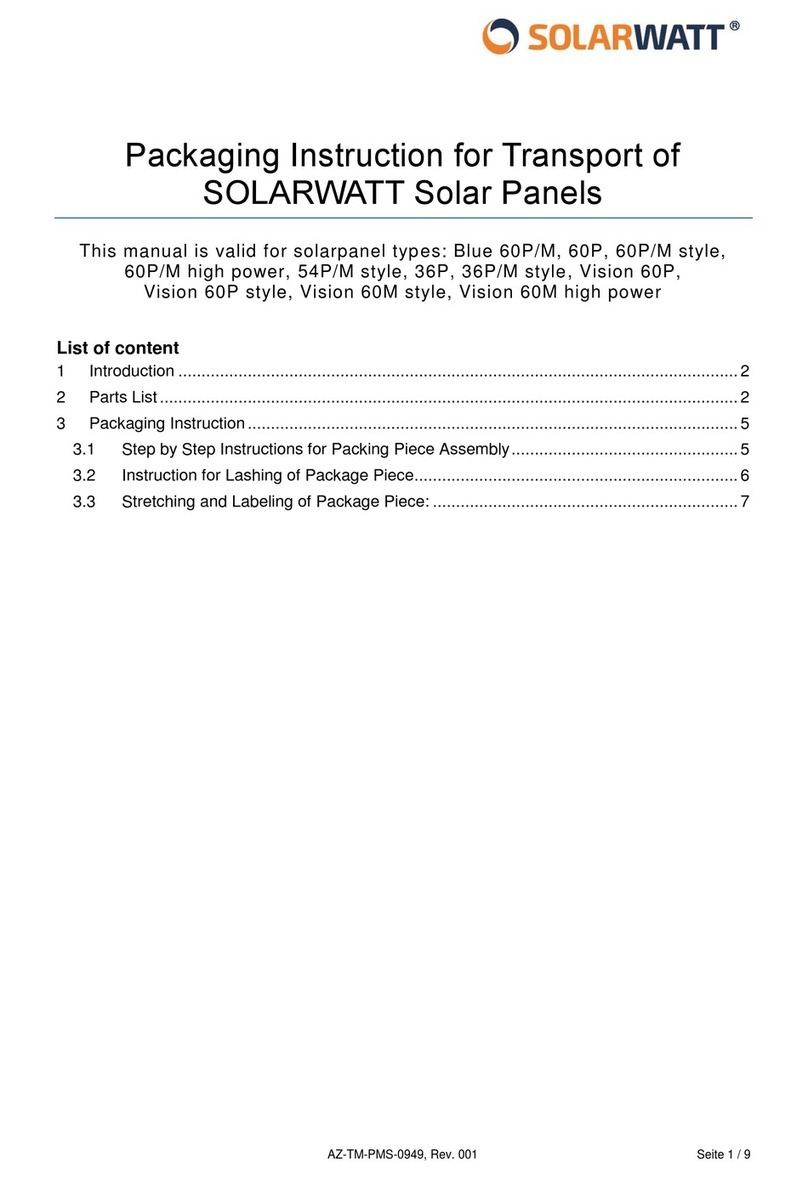
solarwatt
solarwatt Blue 60P/M instructions
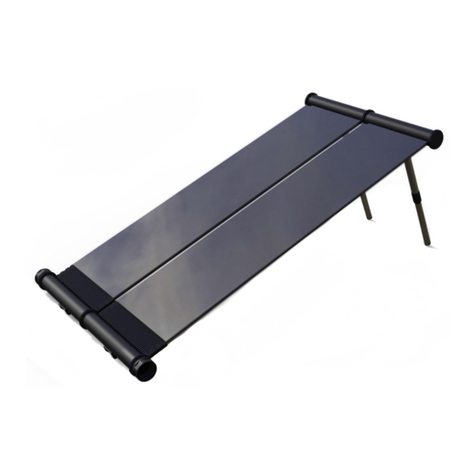
COMFORTPOOL
COMFORTPOOL CP-80021 Installation & operation manual

GRIDFREE
GRIDFREE TINY HOUSE installation manual

AKO-Agrartechnik
AKO-Agrartechnik BA-1161 instruction manual
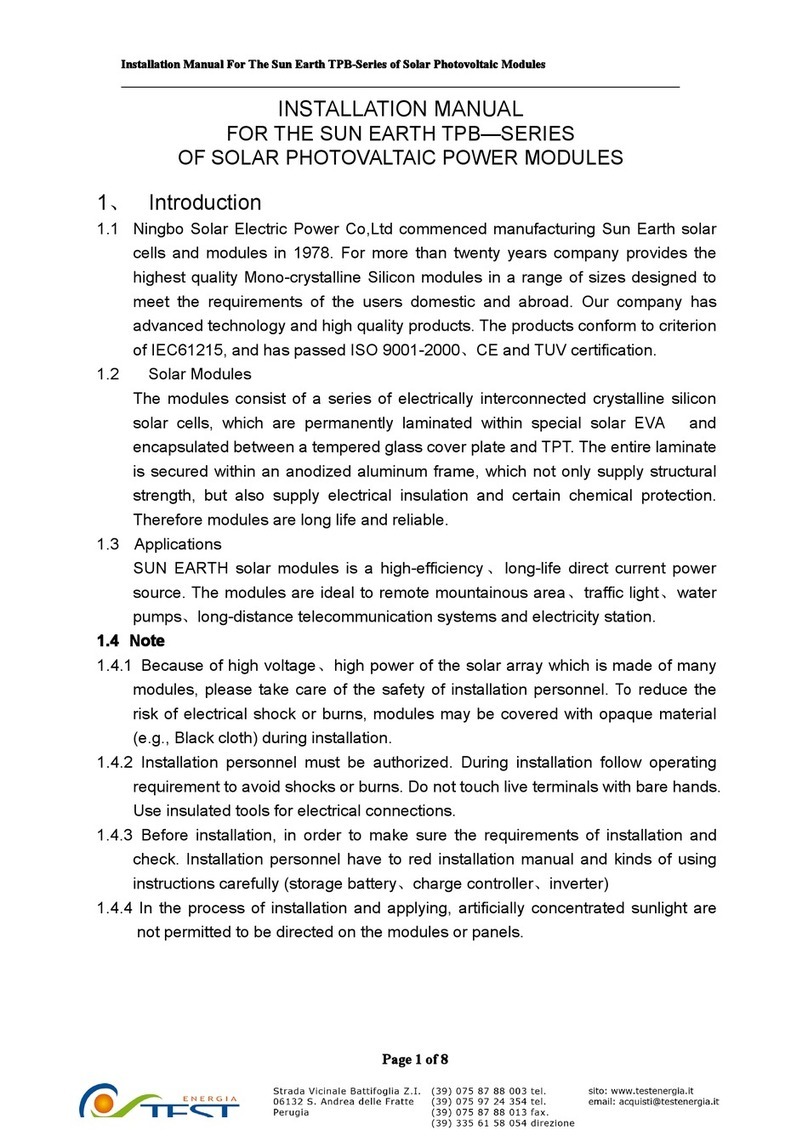
Ningbo
Ningbo Sun Earth TPB Series installation manual
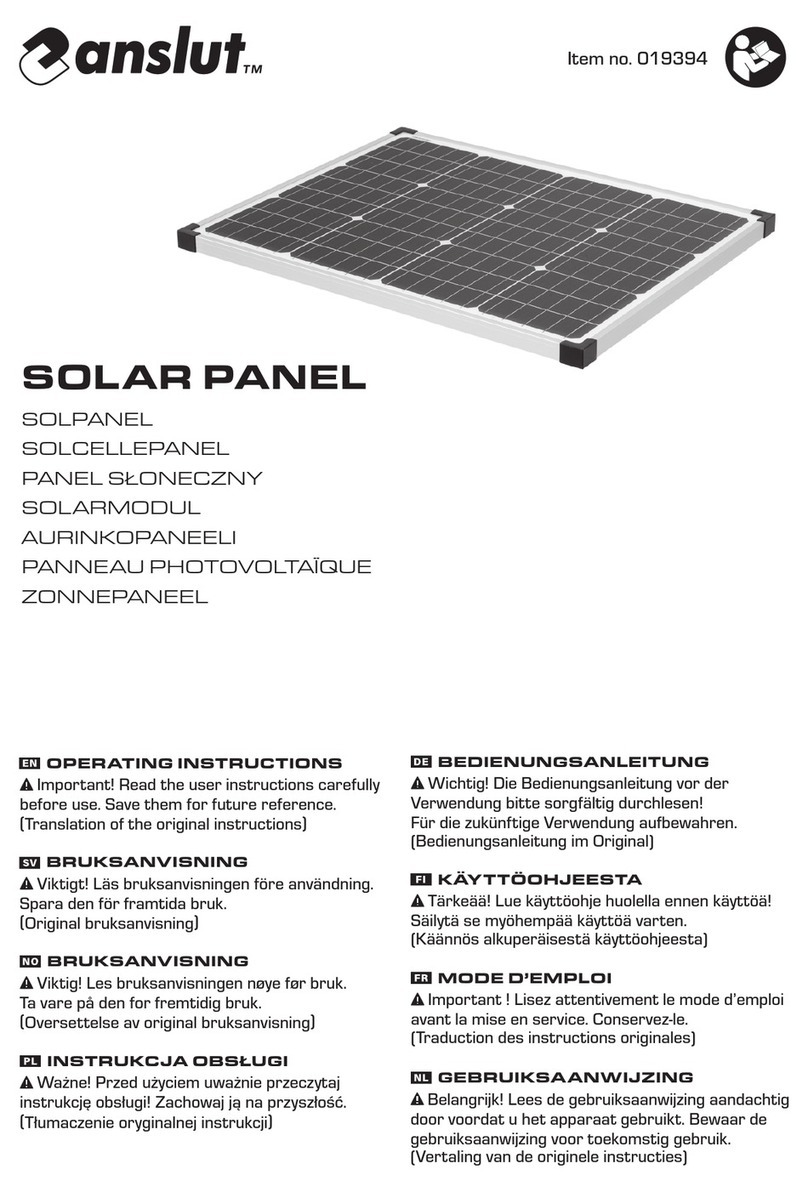
Ansult
Ansult 019394 operating instructions

